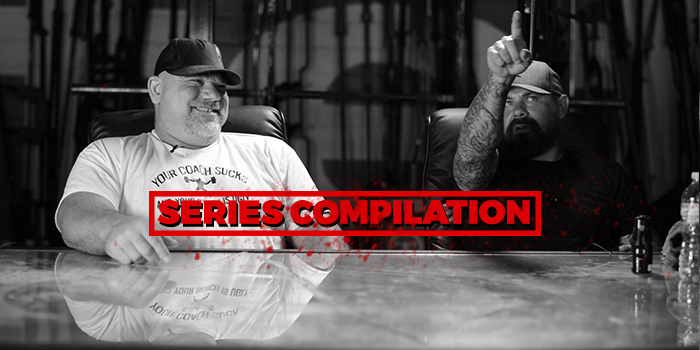
We have good news for those of you who missed the Jim Wendler Open UGSS and the rolling out of each video segment. All in one spot, here is the 4-part series. Jim spoke on a number of topics through his current training work he is doing for high school football players here in London, Ohio. For another listening option, you'll find this series as a playlist on our YouTube channel. Enjoy!
Part 1: Earn the Barbell, Training Philosophy, and Industry Trends
Some of the highlights:
"You may not like me very much, but you can't deny that I love what I do and I've worked very hard just like much of you have."
"When I was in junior high and high school, all I really wanted to do was lift weights and read and write. Everyone always told me 'your'e never going to do anything with that.' It's nice to throw some sand in those fucker's faces."
"I've still got a chip on my shoulder no matter what I do. I always feel like the worlds' against me. It can get tiring sometimes but I think that's really helped me."
"If you can't coach a barbell squat, just don't barbell squat them. Just find a way around it."
"Squat the weakness out of them."
By the minute:
- Lift weights, read, and write (0:20)
- Jim as a football and strength coach (2:30)
- The training philosophy of Jim Wendler (3:39)
- Trends in training and nutrition (5:30)
- High school athlete training: squat out the weakness and earn the barbell (7:22)
- Don't coach or program something that you don't know (10:39)
- Organization (12:25)
- Planning ahead (14:19)
- Working with the sport coach (16:23)
- How training revolves around balance (17:20)
Part 2: Training Standards and Injury Management for Kids
Some of the highlights:
"Do you know how hard it is to coach 40 or 50 kids at one time who literally are dumber than shit? I give no one any choice anymore. There are no choices at all. You do it my way or the highway because what happens is, if you give an inch, they will take more than a mile. It will get worse and worse and worse."
"I give them the illusion of choice on things that don't matter: you can do dips or you can do push-ups."
"There's a difference between being hurt and injured. These kids need to realize that. I don't want to be a jerk about it, but if you're not playing you might as well go crazy a little bit."
"If I can teach a kid to squat correctly, I can teach him anything."
"Everything should be made as simple as possible but not simpler."
"Every high school kid is weak and slow with no muscle."
"Athlete the lower, bodybuild the upper."
By the minute:
- The illusion of choice in training large groups (0:40)
- Everyone needs the same thing (2:27)
- Buddy Ryan and coaching injured players (3:50)
- Teaching a kid how to squat is like teaching a kid how to read (6:15)
- Albert Einstein's rule of simplicity (7:25)
- Specific standards for youth training abilities (8:20)
- Goal setting (11:52)
- Athlete the lower, bodybuild the upper (13:10)
Part 3: Programming Layout for Youth Athletes
Some of the highlights:
"If someone can't do a glute ham raise it's the best thing ever, because our job is so easy."
"This is awesome. You are so piss weak that you can only get better."
"He was an SEC football player, a starter, and he couldn't do a push-up."
"If you watched Walter Payton play you'd think he'd never die. Never. He was the toughest SOB ever."
"Everything is a circuit. Everything. God forbid they get a little bit stronger. There's some really kooky shit I've seen."
"What I have found is that mobility isn't so much about what you do, it's just you doing it consistently. So in order to prevent boredom I have a bunch of different stuff that I do."
"No matter what we do with box jumps, as long as we put it at a fairly high level, kids have to give it 100% effort."
"When you suffer with people, that makes you closer."
"While you're walking perfectly straight, I'm setting world records."
By the minute:
- Middle school athletic training (0:18)
- Mobility program progression (1:10)
- Calisthenics (2:48)
- Walter Payton and the development of an athlete (6:08)
- Balancing training needs (7:10)
- Variety and consistency of everyday mobility movements (10:22)
- Box jumps and throws (10:50)
- Accessory work as conditioning (14:00)
- Mobility at Westside (18:40)
Part 4: Exercise Selection and Attempting PR's
Some of the highlights:
"We live on sets of five. Once the kids are ready we do PR sets."
"We had the JV/Freshman team attempt PR sets and the attitude of the weight room has completely changed now. They think they're the cock of the walk."
"You want athletes to get stronger but not in a smokescreen fashion."
"When you strength train for something other than strength training, it's GPP. "
"For sports, lifting weights is nothing more than GPP, but it has to be specific enough to carryover to your goal."
"It stands for washed-up, lethargic, retired, used-up sportsmen. That's what WALRUS stands for."
By the minute:
- Training parameters for "athlete lower, bodybuilder upper" (0:12)
- Definition of a PR set — more doesn't always mean you're stronger (2:30)
- Strength training is GPP (3:55)
- Core lifts and assistance lifts within the program (5:07)
- The WALRUS Challenge (6:40)
- Can you overhead press instead of a variation of the main movement? (10:01)









